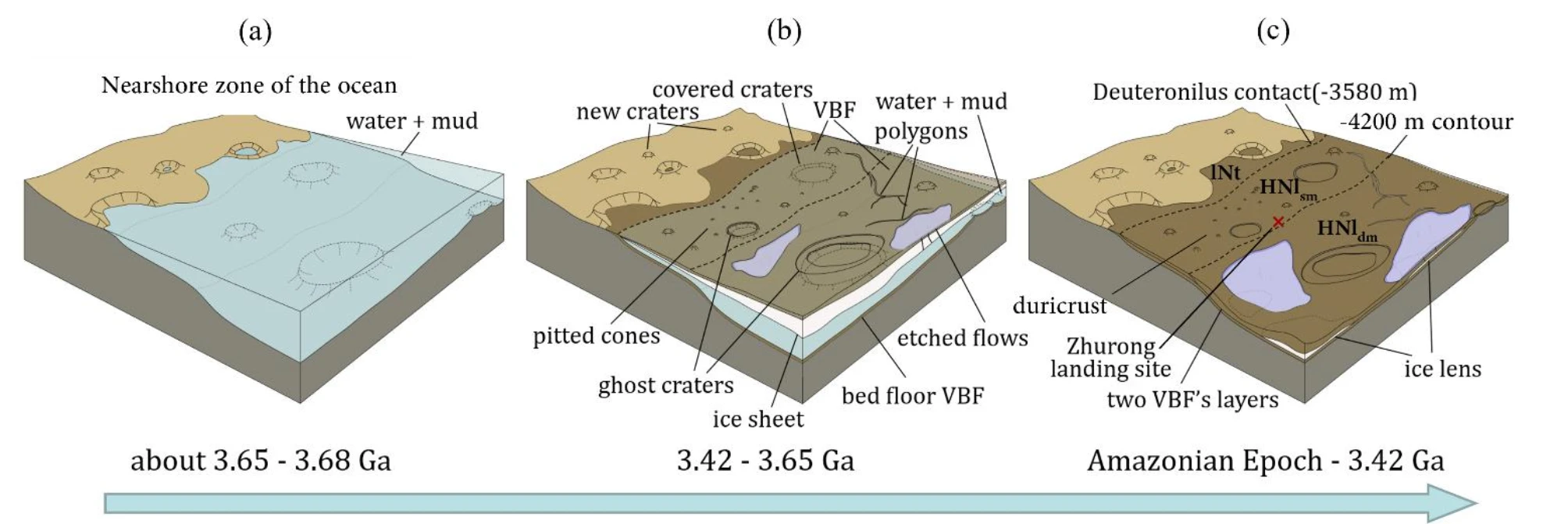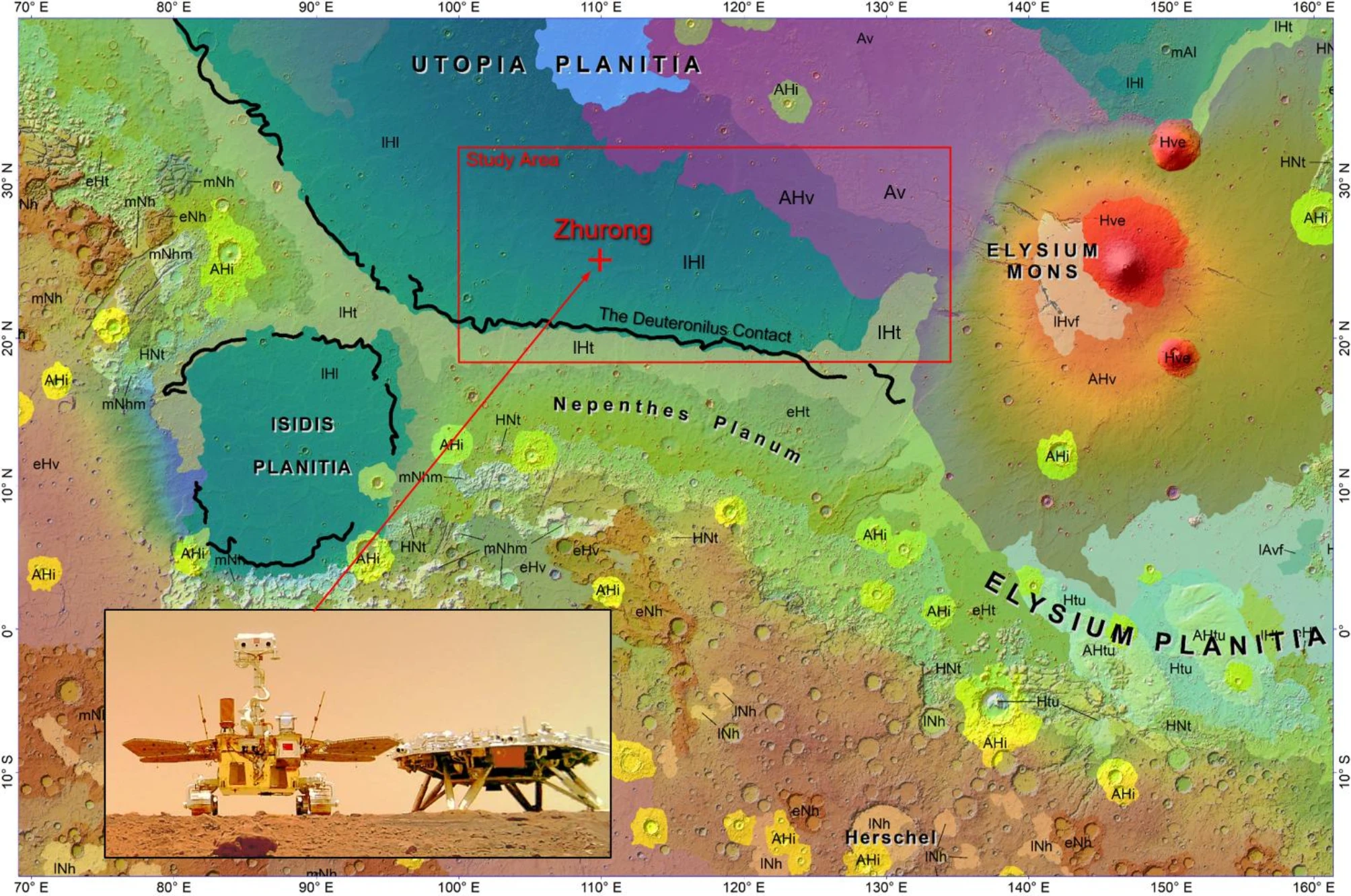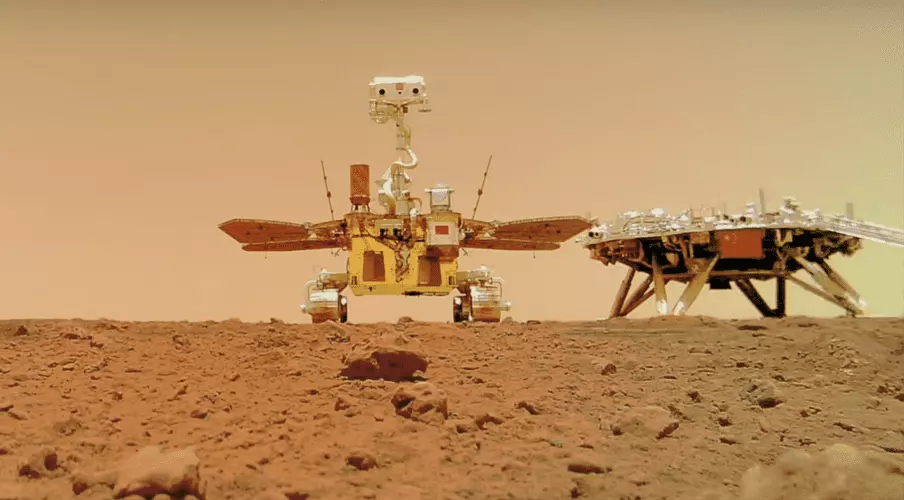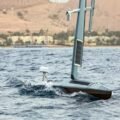China’s Mars rover, Zhurong, has unearthed evidence that strengthens the theory of an ancient Martian ocean once lapping against the dusty shores of the Red Planet’s Utopia Planitia region.
In new research published in Nature, scientists present a detailed study of Martian sediments, topographic features, and water-related mineral formations. The findings reveal tantalizing hints that vast areas of the Red Planet may once have been submerged underwater, offering an exciting new glimpse into Mars’s storied past.


The Chinese Mars rover Zhurong, part of the Tianwen-1 mission, landed in southern Utopia Planitia in May 2021. This region, a lowland basin near the Martian equator, has long been hypothesized as part of an ancient ocean bed.
Recent findings from Zhurong have provided compelling new data to support this theory. They reveal geological markers that suggest Mars was once home to a significant ocean, particularly during the Late Noachian to Early Hesperian periods, around 3.6 to 3.4 billion years ago.
Through advanced imaging technology and in situ analysis, Zhurong has mapped out what appears to be an ancient coastline along Utopia Planitia. This expanse of terrain was initially a mystery, with unclear evidence from previous Mars missions.
However, Zhurong’s high-resolution cameras and spectroscopic instruments have detected sedimentary rocks, water-related lamination features, and specific types of mineral deposits that strongly suggest a shoreline formation.
The rover’s findings offer a rich timeline of how water may have shaped the Martian surface in this region, filling the landscape with standing water bodies that subsequently vanished as Mars lost its atmosphere and climate stability.
One significant breakthrough from Zhurong’s observations is identifying geomorphological features in the Utopia Planitia basin, which appear to align with different marine environments from shallow to deeper water regions.
Researchers categorized the area into distinct zones based on topographic variations and sediment formations, including a “foreshore” transition unit, a shallow marine unit, and a deep marine unit. Each zone contains different sedimentary deposits, suggesting varied water depths and marine conditions across the basin.
The rover identified a “Deuteronilus contact” in this area—a proposed ancient shoreline marking the boundary of water flow that may have once delineated a vast oceanic expanse.
Located at a mean elevation of approximately -3580 meters, this contact line mirrors boundaries found in similar regions on Earth and is believed to be a strong indicator of an ancient Martian ocean’s former reach.
The combination of curvilinear geomorphic patterns, impact crater features, and layered sedimentary deposits in this basin mirrors what geologists would expect from a coastal area undergoing tidal and sedimentary processes.
While remote sensing has been instrumental in mapping the Martian surface, on-site data from Zhurong have brought a closer look at subsurface structures that hint at past water activities.
One significant find is the detection of “pitted cones” and polygonal troughs, formations commonly associated with mud volcanism and sedimentation processes involving water or ice.
Additionally, radar data show stratified layers beneath the surface, each with unique compositions and particle sizes, suggesting a history of repeated flooding and sedimentation.
Zhurong’s spectroscopic instruments have analyzed various rock types across Utopia Planitia, detecting hydrated minerals and even the potential presence of hydrated silica, a mineral often associated with liquid water on Earth.
These findings are supported by spectral data pointing to ancient interactions with water, possibly even in periglacial or near-shore environments. The presence of these minerals aligns with theories that the Utopia Planitia basin was once a substantial water reservoir, with conditions that supported mineral-rich, water-related sedimentation before eventually freezing or evaporating as Mars cooled.
Using crater size-frequency distribution (CSFD) analysis, scientists estimated the ages of various geological units in Utopia Planitia, mapping a timeline of the basin’s transformation.
These age estimates point to significant flooding events around 3.65–3.68 billion years ago, with the subsequent formation of shallow and deep marine zones as the water body gradually receded. By approximately 3.42 billion years ago, much of the oceanic expanse had solidified or evaporated, leaving behind mineral-laden soil and sedimentary formations indicative of its former presence.
Interestingly, some radar data suggest that remnants of this ancient ocean may still lie trapped beneath the surface as layers of ice or hydrated minerals, potentially persisting into the Amazonian epoch, which spanned the last three billion years of Martian history.
If confirmed, this would mean that Mars retains vestiges of its wetter, warmer past, preserved beneath the arid desert landscapes seen today.


While the findings by China’s Zhurong rover appear to support the theory of a vast ancient ocean on Mars, not all scientists are thoroughly convinced.
Speaking with AFP, Dr. Benjamin Cardenas, a planetary scientist and Mars researcher from Pennsylvania State University, expressed a measured skepticism, pointing out that Mars’s dynamic surface conditions over billions of years make it challenging to interpret specific features as definitive evidence of an ancient shoreline.
Dr. Cardenas argues that the study may only partially account for the erosion and sediment movement driven by Mars’s strong winds, which can wear down rocks and alter surface features over vast stretches of time.
“We tend to think of Mars as not very active, like the moon, but it is active!” Dr. Cardenas explained. He highlighted that even “the slow Martian erosion rates” could gradually erase or modify traces of an ancient shoreline.
Dr. Cardenas’ skepticism is rooted in prior modeling research, which suggests that Mars’s surface, while less active than Earth’s, has still undergone enough geological change to challenge the preservation of a stable, recognizable coastline. According to Cardenas, wind erosion, combined with billions of years of impact events, might have scattered or buried what could have once been coastal sediments.
Lead study author Bo Wu of The Hong Kong Polytechnic University acknowledges this, noting that meteor impacts can periodically excavate and bring buried sediments to the surface.
While Wu’s team observed features such as pitted cones and polygonal troughs around Zhurong’s landing site—formations that often signal past interactions with water or ice—Wu clarifies that their findings are not a conclusive confirmation of an ancient Martian ocean.
Instead, they add a piece to the puzzle, suggesting that an ocean could have formed around 3.7 billion years ago, froze, and gradually disappeared approximately 3.4 billion years ago.
While skeptical of the certainty of these specific findings by Zhurong, Dr. Cardenas is nonetheless intrigued by the broader implications. “I tend to think there was an ocean on Mars,” he admitted, underscoring that discovering a past ocean on the Red Planet could have implications for understanding Mars’s potential to support life.
Life on Earth likely began in or near water, with primordial seas or tidal pools providing essential environments for life to thrive. Evidence of a Martian ocean would present an exciting prospect, suggesting Mars might once have been a more hospitable planet, with environmental conditions suitable for early forms of life.
This new evidence offers a tantalizing destination for future missions. If Mars once held vast oceans, as the evidence suggests, these ancient shorelines could be prime locations for finding fossilized microbial life or other biosignatures.
These findings underscore the importance of using both orbital and surface-based missions to fully understand the Red Planet’s climate evolution.
Zhurong’s findings are expected to fuel more targeted missions to Utopia Planitia and other lowland regions on Mars, where further analysis might reveal more about Mars’s climate history and its potential for life.
In a landscape that now appears desolate, the discovery of ancient shorelines invites us to imagine a Mars that was, at least for a time, a world of lakes and oceans, much like early Earth.
Tim McMillan is a retired law enforcement executive, investigative reporter and co-founder of The Debrief. His writing typically focuses on defense, national security, the Intelligence Community and topics related to psychology. You can follow Tim on Twitter: @LtTimMcMillan. Tim can be reached by email: tim@thedebrief.org or through encrypted email: LtTimMcMillan@protonmail.com

